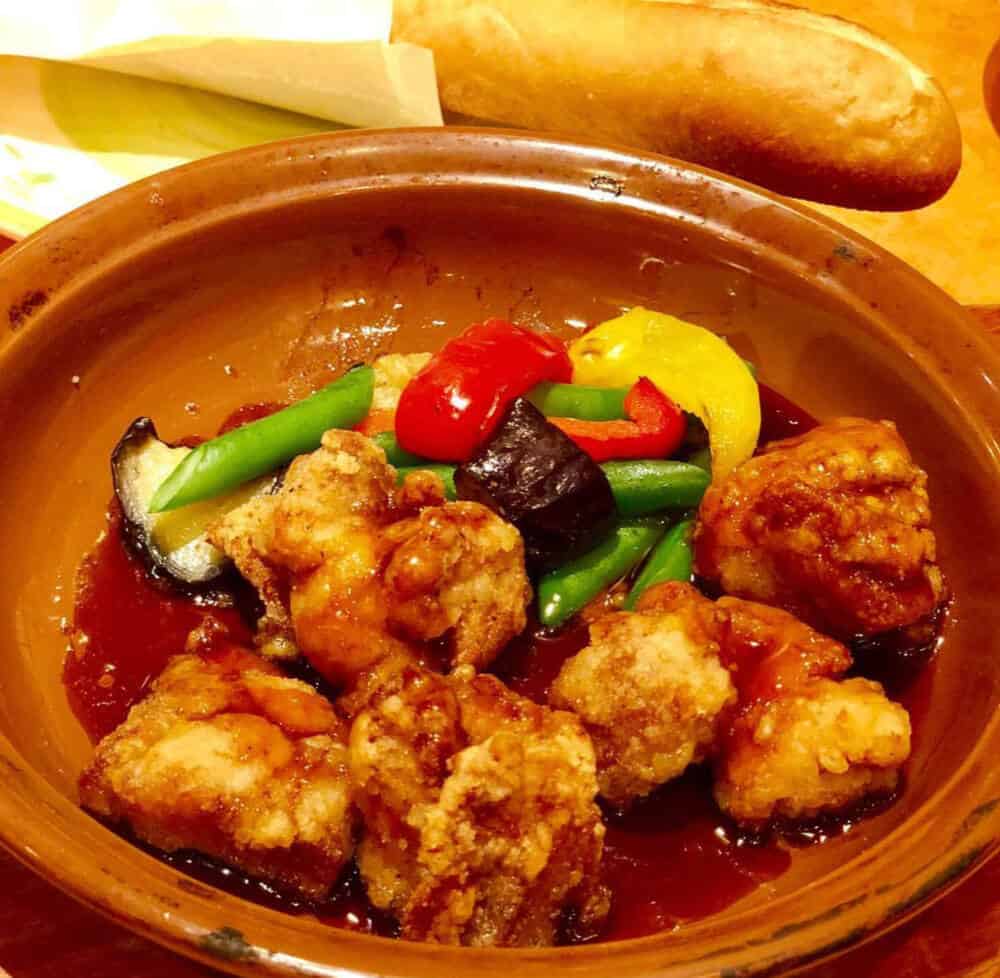Here’s the best way to spend 1000 yen at restaurant Saizeriya.
I had the pleasure of visiting Saizeriya, a popular Italian restaurant chain in Japan renowned for its exceptionally affordable prices.
With a self-imposed limit of 1,000 yen, equivalent to about $7.65, I aimed to construct a fulfilling meal, a challenge that pushes one’s creativity and understanding of value.
Below, I’ll share varied approaches I and others took to dining on a budget at this beloved eatery.

Page Contents
How To Spend 1000 yen At Restaurant Saizeriya?
My Intriguing Garlic Shrimp Creation For 1000 yen at Saizeriya
- Salad: Fresh Garden Salad – 350 yen
- Bread: Flavorful Garlic Toast – 200 yen
- Appetizer: Crunchy Popcorn Shrimp – 300 yen
- Seasoning: Addictive Yamitsuki Spice – 50 yen
- Drink: A Sip of Red Wine – 100 yen

Hawaii holds a special place in my heart, symbolized by the flavors of garlic shrimp from my wedding trip.

By innovatively combining the garlic bread with shrimp, vegetables, and a sprinkle of Yamitsuki Spice from Saizeriya, I recreated that tropical taste. The accompanying red wine, surprisingly within the budget, helped to round out the meal.
A Newcomer’s Meat-centric Choice For 1000 yen at Saizeriya
- Entree: Savory Hamburger Steak with Chorizo – 550 yen
- Bread: Petite Mini Ficelle Bread – 150 yen
- Drink: Refreshing Glass of Beer – 300 yen
After a long hiatus, I returned to Saizeriya and though it took a while, I opted for hearty meat options, investing a significant portion of the yen in a frothy beer.
My choice was satisfying, albeit the portion smaller than anticipated, leaving me slightly unfulfilled in terms of quantity.

An Hour of Delightful Indulgence For 1000 yen at Saizeriya
- Drink: Half-Liter Decanter of Red Wine – 400 yen
- Appetizer: Oven-Roasted Escargot – 400 yen
- Bread: Tasty Focaccia – 150 yen
- Seasoning: Moreish Yamitsuki Spice – 50 yen
I often frequent Saizeriya, and this time my intention wasn’t to squeeze a full meal from 1,000 yen but rather enjoy a series of snacks complemented by wine.
The escargot offered a gourmet touch and the residual garlicky butter paired perfectly with the focaccia, creating a sophisticated snacking experience.
A Nostalgic Trip with Staple Dishes For 1000 yen at Saizeriya
- Rice Dish: Cheesy Milano-style Doria – 300 yen
- Pasta: Zesty Pepperoncino Pasta – 300 yen
- Entree: Classic Hamburger Steak – 400 yen
“Well, you guys are trying too hard,” I remarked with confidence. Recalling the excitement of adolescent dining at Saizeriya, I chose familiar comfort foods.
These staples resonate with timeless contentment and my creativity shone when I added the egg from the hamburger steak to the pasta for a uniquely personalized touch.
Quest for Culinary Harmony For 1000 yen at Saizeriya
- Entree: Aromatic Arrosticini – 400 yen
- Pasta: Spicy Pepperoncino Pasta – 300 yen
- Vegetables: Nutrient-rich Vegetable Paste – 100 yen
- Salad: Crispy Green Beans and Pecorino Cheese – 200 yen
Lamb skewers, or arrosticini, are my absolute favorite at Saizeriya. Considering a balanced diet, I included pepperoncino pasta for carbohydrates and vegetable paste for an extra nutritional punch.
The salad brought freshness and dairy into the mix, achieving a well-rounded dining experience.
Despite the diversity in our orders, everyone left the table with a smile and their particular cravings satisfied. It was a practical demonstration of how Saizeriya caters to various palates and preferences, even on a stringently tight budget.
Leading to the realization that, in Japan, you can certainly enjoy a fulfilling meal without spending more than a modest 1,000 yen.

Economical Eating Spots for the Thrifty Traveler in Tokyo
Tokyo offers several budget-friendly dining alternatives for travelers looking to save money. Convenience stores such as Lawson and FamilyMart provide a range of pre-packaged meals that are both inexpensive and satisfying.
Local ramen shops, where a steaming bowl can often be enjoyed for less than 1,000 yen, are abundant.
Shibuya is renowned for its hustle and bustle, and amidst this vibrant district, one can find delectable yet affordable dining options.
Small izakayas (Japanese pubs) and takeout spots around the Shibuya Station often offer meal sets or bento boxes at very reasonable prices. Small sushi joints near the train station also serve quality sushi at a fraction of the cost of high-end sushi bars.
Fine dining on a budget in Japan is possible by seeking out lunch specials at high-end restaurants or exploring local dishes at smaller, family-run establishments, which often exude a depth of culinary expertise at a lower cost.
Certain times of the year, restaurants may participate in city-wide events offering discounted meals, making gourmet experiences more accessible.
Shinjuku’s side streets are a gold mine for discovering inexpensive eateries. Omoide Yokocho and Golden Gai are two areas where I can indulge in yakitori (grilled chicken skewers) and other small plate items without overspending.
These areas offer a variety of choices, so I always have a place to grab a bite without the hefty price tag.
In Tokyo, experiencing the prestige of Michelin-starred dining without emptying my wallet is achievable by opting for lunch menus, which are typically a fraction of the dinner price.
Many Michelin-starred ramen and sushi establishments offer lunch set menus that provide a taste of luxury dining on a more modest budget.
Japan’s street food is a must-try for economical explorers seeking a flavorful adventure.
Takoyaki (octopus balls), okonomiyaki (savory pancakes), and sweet taiyaki (fish-shaped pastries filled with red bean paste) are iconic treats that are widely available and easy on the wallet.
Each bite encapsulates the essence of Japanese street cuisine at an affordable cost.
My writing focuses on the various aspects of Japanese lifestyle, from traditional tea ceremonies and flower arrangement to modern fashion trends and pop culture. Through my articles, I aim to share my passion for Japan and provide readers with a glimpse into the rich and diverse world of Japanese culture.
I believe that the key to understanding Japanese lifestyle is to appreciate the balance between tradition and innovation. While Japan has a rich cultural heritage that dates back centuries, it is also a country that is constantly evolving and embracing new ideas and technologies.
Whether you’re interested in learning about the latest fashion trends in Tokyo, or want to explore the ancient art of calligraphy, my writing will take you on a journey through the many facets of Japanese lifestyle. So join me as we explore the beauty and complexity of this fascinating culture together!





